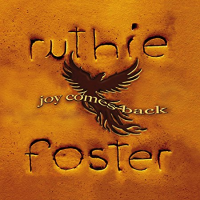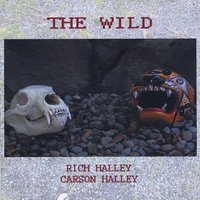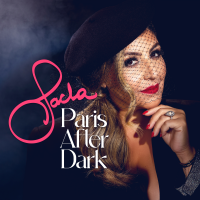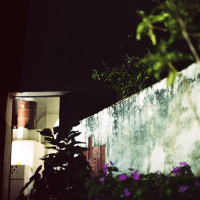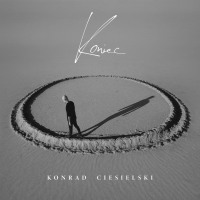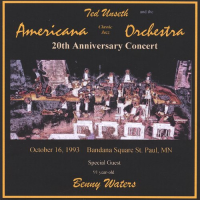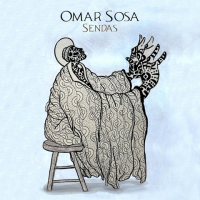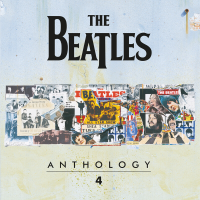Home » Jazz Articles » Album Review » Mahavishnu Orchestra: Apocalypse
Mahavishnu Orchestra: Apocalypse
So, a remastering it isn't, but that doesn't mean it's off the agenda. There are very skilled experts queuing up to do it, but it would help music labels like Talking Elephant, who (re)produced this version, and are genuinely passionate about the music and its legacy, if Sony would be so kind to slightly remove their talons from the flesh of some of the greatest music ever made. If they're doing nothing with it, then it would be very nice indeed if they would please share the original track recordings with people who will, and NOT JUST THE FINAL MASTER TAPE, which is like asking a brain surgeon to operate on a brick. Set the music free, their vibrations to find new ears in augmented reality. Go on, please release the beast.
That said, if you already have the 2009 Sony release, then you already have this music, and if you don't, are you mad? This is only awesome made audible, more so by the great feat of marrying disparate musics. Bringing together modern and classical, amplified and acoustic instrumentation, must be the hardest fusion to accomplish where you don't just end up with band with orchestra, or Rondò Veneziano. There are some great successes: Emerson, Lake & Palmer obviously, Rick Wakeman, and a personal favourite, Caravan who used the New Symphonia superbly to stratify the climax to "For Richard." I'd add Deep Purple's unsophisticated, but quite endearingly beautiful, early efforts on their 1969 Concerto for Group and Orchestra, which in parts used the rock group to augment the orchestra, rather than the more typical other way round. But, like putting a sitar in a pop tune, or adding strings to a rock anthem, they are just arrangements, and it's not really fusion, until a new form emerges from the elemental mixture.
One effort that does feel fully integrated is Mark-Anthony Turnage's Scorched with John Scofield, Peter Erskine and John Patitucci. Easily on a par with Herbie Mann's Concerto Grosso In D Blues and Duke Ellington's more orchestral pieces like The Afro- Eurasian Eclipse, it's really very clever, in avoiding the usual pitfalls of marrying disparate musicians rather fiendishly. On the whole, it gets around the problem by mostly avoiding it. Instead, motifs and themes are played through in classical style by the Radio Symphony Orchestra Frankfurt, stretching the orchestral range, using percussive plucking from the first violins, cellos and basses to create a language for call and response between orchestra and jazz trio, a shared pulse, who follow back-to-back, with highly similar interpretations of the same pieces. Trio and orchestra do meet on the same score page, but when they do a basis for their communication has already been established through recognition of their differences, as much as of their harmonic potential. It's a hard act to accomplish, and it's certainly one of the best.
But, the best? Without a doubt, it is this: Apocalypse is a huge musical statement, that draws upon monumental creative energy, to make itself heard, including, the London Symphony Orchestra conducted by Michael Tilson Thomas, with George Martin producing. When Zen Guru Miles Davis told John McLaughlin it was time to find his own path, and Guru Chinmoy had provided him the moniker Musician to the Gods, Mahavishnu must have felt his life had led to that exact point within the eternity of time. No doubt mustering the lessons learnt from his myriad of past musical experiences, he conceived this new band as an orchestra, something that proved not possible for the original lineup, but when time came for reincarnation, in the form of Mahavishnu Orchestra II, the avatar on Apocalypse is the closest McLaughlin ever got to that original concept.
Given McLaughlin's past in skiffle, pop and jazz, one might wonder where the Orchestra bit did come from? The answer is probably, that classical sensibilities were seeded early on, Happily, my mother was an amateur musician; she was a violinist and there was always music going on in the house. We got a gramophone one day, and someone had Beethoven's Ninth, and on the last record, which is at the end of the symphony, there's a vocal quartet in which the writing is extraordinary ... the voices and the harmonies. I must have been about six or seven when I distinctly remember hearing it for the first time. I suppose that's when I started to listen. Because when you're young, you're not paying attention. What do you know when you're a kid? It was unbelievable, what it was doing to me was tremendous. I began to listen consciously to music and I started taking piano lessons when I was nine[1].
Likely, as a consequence , classical music has been integral to McLaughlin's repertoire throughout; a German article refers to him as, the Paganini of the jazz guitar. Irrespective of his legendary precision virtuosity, his classicist leanings permeate straight into the succeeding album, Visions Of The Emerald Beyond which was released in February 1975. Straight off, Jean-Luc Ponty's violin is cleverly double-tracked, for fuller, choral layering, and a truly immense sound. While this vast, sweeping string section drapes itself across the music's broad shoulders, a rising allegro of determined, piano ostinati skips through the central tumult with similar colourings to a Rachmaninov concerto. While many jazz artists favour the acerbity of Stravinsky, especially his Rite of Springs: Hubert Laws, Alice Coltrane, Ornette Coleman, Charlie Parker, Al Di Meola, Stanley Clarke (also with Jean-Luc Ponty); McLaughlin clearly has an empathy for the Romantics, from Beethoven to Scriabin[2], but also the grandeur of Nationalistic American composers, especially Leonard Bernstein and Aaron Copland[3].
McLaughlin's aptitude for writing in the classical form is unsurprisingly most evident from his compositional mastery, attested to by the Mediterranean Concerto (For Guitar & Orchestra), also with Tilson Thomas, and Thieves and Poets, but look further afield, for example, his arrangements and writing for classical pianists, the Labèque sisters, plus Shakti which was also built upon classical foundations.
The rhythms of Hindustani and Carnatic classical styles at the heart of each Shakti piece, identified a basis for mutual understanding, towards a fusion of Indian classical music and aspects of Western jazz. Its language provided a means of communication: the vocalisation of these rhythms using the syllable system of Konnakol, whilst counting off beats in the taal, and incorporating a khali wave to mark the first beats, for example, Dha Dhin Dhin Dha | Dha Dhin Dhin Dha | Dha Tin Tin Ta | Ta Dhin Dhin Dha, fits a Teen Taal of 16 beats. Hindi and English are of secondary value, when you're fluent in music.
One of the most amazing features of McLaughlin's composing is that, not only does he effortlessly fuse classical and jazz, but there are also phrasings and measures from various sources dotted throughout, from Blues phrasings, to signature bends and vibrato, cultured while learning vina. Classical leanings can be heard through his penchant for the Phrygian dominant scale. It's an adaptable choice, regularly appearing in Flamenco, Indian, Arabic and European musics, it can also be found in many classical pieces, by, Bach, Bartok, Liszt, Rimsky Korsakov, Vaughan Williams, Ravel, Philip Glass, and, Paganini (the Mahavishnu of the violin?). As with Konnakol, finding a building block fundamental to more than one musical genre must be a bonus when looking for common threads to entwine, There were certain principles I applied to the Mahavishnu Orchestra that were certainly derived from Indian, maybe mathematical concepts, rhythmic concepts or even melodic concepts, since it is fundamentally melodic and rhythmic music in India ... I don't believe one can talk about east-west fusions in music. One can only speak in personal terms - that's people ... For me, that's where the fusion takes place. It's not in the music. If you try to make a, east-west fusion, you're going to be a miserable failure right away.[4]
McLaughlin has united apparently disparate musics, time and time again: Indian, Flamenco, Jazz for the Trio and Que Alegria; Classical, Jazz and traditional folk songs, for the soundtrack to Molom, A Legend Of Mongolia; Flamenco, Blues and Jazz for the Guitar Trio; and, well worth finding a copy, the unreleased John and Eve McLaughlin disk that was going to accompany a side of Shakti, creating a double album to follow Visions in mid-1975, which brings together Indian, folk, jazz, classical, spiritual, and a whole host more.
One track in particular, the Burt Bacharach & Hal David-penned, "Share The Joy," is a return to playing with Tilson Thomas and the Boston Philharmonic Orchestra. With Carlos Santana mooted to be on second guitar, there are no hints of the raw power of the previous Love Devotion Surrender, but instead a wonderful tour through stage show musical, lush romantic strings and stirring brass, into a hypnotic cello and acoustic guitar motif, that builds in flurries; McLaughlin's rapid solo bursts merging into a bank of horns, accenting the refrain. A drone picks up, and the sweetest delicate interplay, between ethereal voices, cascades of guitar notes, punchy chords, whispered woodwind and solo trumpet, has all the haunting marks of Gil Evans and Davis, and the futurism of Palle Mikkelborg and Aura.
But we're getting ahead of ourselves. Rewind to March '74, and I think I'm right in saying that there was only once when a track from Apocalypse was performed live with full arrangement, rather than, say, the parred down ensemble that lifted the roof off the Montreux Convention Center later in the year. The difficulties of holding it all together, the synchronisation despite volume differentials, touring with so many people and their equipment, created simply too big a barrier. Except, for one gig, a few weeks before recording the album, an impromptu outing to fill a gap left by Isaac Stern who had been booked to play with the Buffalo Philharmonic. Tilson Thomas happened to be already working on the Apocalypse music, along with Michael Gibbs, an old London friend of McLaughlin's, who greatly assisted with scoring the orchestral arrangements, and provided the serpentiform introduction to "Wings of Karma," closely based on Schoenberg's Begleitungsmusik zu einer Lichtspielscene (Op. 34, 1929). Anyway, so when Stern dropped out, Tilson Thomas offered McLaughlin the slot, which was keenly accepted to try out the band's first rehearsed piece, "Hymn To Him." Narada Michael Walden remembers, 'It was about 20, 25 minutes long, a very triumphant piece ... I didn't want to leave the stage, it was a standing ovation and I just couldn't believe what was happening. It was phenomenal. And I guess not long after that we were told we would be working with George Martin ..., and Michael Tilson Thomas would be conducting the London Symphony. [4]
The experience was also profound for Paul Sorgule, Musicians depend on interplay, the electricity of being on the same page, trust, common vision, and all types of communication as well as talent. I could distinguish, quite easily, between musicians who were conditioned to the structure of reading music vs. those that felt the music, were connected with others in a band, and were locked into the audience that they played for. There was (is) an energy that certain musicians are able to tap into, an energy that others seem to miss. When that energy is tapped into—the music is magical ... I remember watching John McLaughlin, by far one of the most incredible guitarists to emerge through the mentorship of Miles Davis, lead his group—The Mahavishnu Orchestra, in a concert backed by the entire Buffalo Philharmonic Orchestra. I watched McLaughlin and his violinist, Jean Luc Ponty, rip through some incredible music as the enormously talented philharmonic musicians looked on in amazement. The band was tapped into the energy.[5]
An encouraging outing for everyone, no doubt, but I think the inspired decision that makes Apocalypse so good, was McLaughlin choosing to record it in London. This must have been predominantly to bring in Martin on production. Their admiration was mutual, although, it must have snubbed a few Buffalo Philharmonic noses, to whisk their conductor away, to work with another orchestra half way around the world. Depending on whom you ask, Martin was, or wasn't, very involved, but going by his previous track record, he was an ideas man, and they can be cannily elusive, and allusive.
Martin had previous experience with everyone from The Goons to Gershwin (his Desert Island Disk of choice was Bess, you is my woman now, soloist Willard White with the Cleveland Orchestra). Famously recording for Parlophone at Abbey Road Studios, he bought the studios for Associated Independent Recording, to offer licensed recordings to labels, that he had produced freelance, where, despite his achievements elsewhere, he wrote in his autobiography, that Apocalypse was one of the best records that he had ever made[6]. Elsewhere, he's also commented it was one of the most difficult. In a discussion on improvements in microphone technology, especially in tolerating loud volumes, Martin, used those sessions to describe the difficulties of recording extreme audio ranges, Simply in terms of decibels it's a very different technique from recording a string quartet. This was never more in evidence than when I recorded the Mahavishnu Orchestra for Columbia. The album was called Apocalypse, and was, I think, one of the best records I have ever made. Mahavishnu was a rock-jazz group led by John McLaughlin, and they were backed by the London Symphony Orchestra, conducted by Michael Tilson-Thomas. Since it was what I would call a very live sort of work, I said at the start: 'Let's try and record this live. It's very extreme, but let's see if our techniques can cope with it.' So I got the LSO into our big studio at AIR and put the Mahavishnu group in the corner. It was all fairly cramped.
I got a good sound balance on the orchestra. I got a good sound balance on the group. But when they started playing together, Apocalypse wasn't the word for it-It was impossible. I was standing beside Michael Tilson-Thomas on the rostrum and, after three or four bars, he flung down his baton, and said in desperation, 'George, I can't even hear the first violin down here.' Although the group were way over in the corner, you could hear nothing else; the difference in sound level must have been about sixty decibels.[6] So I changed tack quickly. Working in a studio of one's own design was an advantage. I decided to use two studios in harness, linking them by audio so that they could hear each other, and it seemed to work. I wanted to avoid overdubbing if possible, so the result was pretty well all live. A little repair work was done by overdubbing, but not much.[4]
Perhaps it's easy to see how Sir George would have been enchanted by the broad brushstrokes of "Smile of the Beyond," Gayle Moran's voice floating above the swell of strings below. It's a melody not dissimilar to Martin's own melodic layering, written for the orchestral film score to Yellow Submarine.
At other times, when the expanse of the music comes to the fore, filling every corner of your auditory range, perhaps that evocation of Copland's prairie vastness occurs. Then there's that gorgeous meander to open "Hymn to Him" : along pretty paths, lined by lotus flowers, dripping their aphid visitors' honeydew into the mottled sunlight cast betwixt golden leaves, overlapping to forming an exquisite lattice like the most delicate jali in a faraway Rajasthani princess's palace. A casual glance over shoulder to see a ruddy great big tiger bearing down on you! The guitar licks flutter faster, the heart strings quicken, and it's a bolt for safety, like the clappers straight into that explosive middle section, to make it to the other side, collapsed on your charpoi, the pulsatory strings scratching on the air, as lungs rasp for breath. That sudden cliff edginess, the sudden Hitchcockian chill, only a string section can muster. And all the while, band and orchestra complementing, and working harmoniously. For me it's the most exemplary piece to come close to a true fusion of electric and orchestra. My only problem with it, is that I love it so much, I never hear the catastrophic message suggested by the title that it is meant to bring. If the end of the world is going to be played out to Apocalypse, then it's not all bad.
As mentioned, Talking Elephant didn't have the wherewithal to carry out the much needed remastering, nonetheless, it's an appreciated dedication to the music to keep this album in circulation. However, it's a shame the aspects which they could have improved upon are left wanting. The printing is a little garish, where a touch less saturation and contrast would have recaptured the calmness of the original LP cover, on which, the yellow and white within Chinmoy's silhouette blend, but on the CD insert are too strongly defined. The track list appears at the rear of the jewel case. This leaves the insert as a single sheet, with the original poem nicely reproduced on the back, and inside, the group photograph, with outline and key naming the ensemble to the side. Here's where I have to have a gripe: if this release is going to be attractive to Mahavishnu fans, then it has it offer something new. The least I would have hoped for is a repair of that group photo. If you've ever seen it before, the top-right, with Ralphe Armstrong, Gregory Digiovine, Michael Walden and Philip Hirschi, was overexposed in the original, meaning they are washed out with a yellow light, and not as in focus as the others therein assembled. Half an hour fiddling with this in an image manipulating app made quite an improvement, so at least the whole photo looked balanced. It's a shame this wasn't thought of, or thought worthwhile.
The second major oversight was not to have included any liner notes. There are many experts on Mahavishnu John McLaughlin residing on the web, any number of them with insights and details to share on this awesome album. It deserves more, and an essay on production and an update about the players would have been cool. Not least, a new photograph or two, of Martin and McLaughlin in the studio booth have come to light, and what a coup that would have been, to include them in new liner notes. If the chance arises again, more can, and should, be done for this most amazing Mahavishnu music.
Further reading
[1] Coffee and Chocolates for Two Guitars Robert Fripp (Musician 1982)
[2] Q&A: John McLaughlin Talks Miles Davis, Indian Philosophy and Frank Zappa's Jealousy Darryl Smyers (The Dallas Observer, 29 November, 2010)
[3] John Mclaughlin Fulfills The Promise Matt Resnicoff. (Guitar Player magazine, April 1996)
[4] Bathed in Lightning Colin Harper (Jawbone 2014)
[5] The Parallels Between Cooks & Musicians Are Hard To Deny Paul Sorgule (Harvest America Vent. 2016)
[6] All You Need is Ears George Martin, Jeremy Hornsby (Macmillan 1979)
Track Listing
Power of Love; Vision is a Naked Sword; Smile of the Beyond; Wings of Karma; Hymn to Him.
Personnel
Mahavishnu Orchestra
band / ensemble / orchestraThe London Symphony Orchestra
band / ensemble / orchestraJohn McLaughlin: guitar; Jean-Luc Ponty: violin; Gayle Moran: keyboards and vocals; Michael Tilson Thomas: Cconductor and piano; Marsha Westbrook: viola; Carol Shive: violin, vocals; Philip Hirschi: cello, vocals; Michael Walden: drums; Ralphe Armstrong: bass, vocals; London Symphony Orchestra.
Album information
Title: Apocalypse | Year Released: 2017 | Record Label: Columbia Records
Tags
About Mahavishnu Orchestra
Instrument: Band / ensemble / orchestra
PREVIOUS / NEXT
Support All About Jazz
 All About Jazz has been a pillar of jazz since 1995, championing it as an art form and, more importantly, supporting the musicians who make it. Our enduring commitment has made "AAJ" one of the most culturally important websites of its kind, read by hundreds of thousands of fans, musicians and industry figures every month.
All About Jazz has been a pillar of jazz since 1995, championing it as an art form and, more importantly, supporting the musicians who make it. Our enduring commitment has made "AAJ" one of the most culturally important websites of its kind, read by hundreds of thousands of fans, musicians and industry figures every month.





